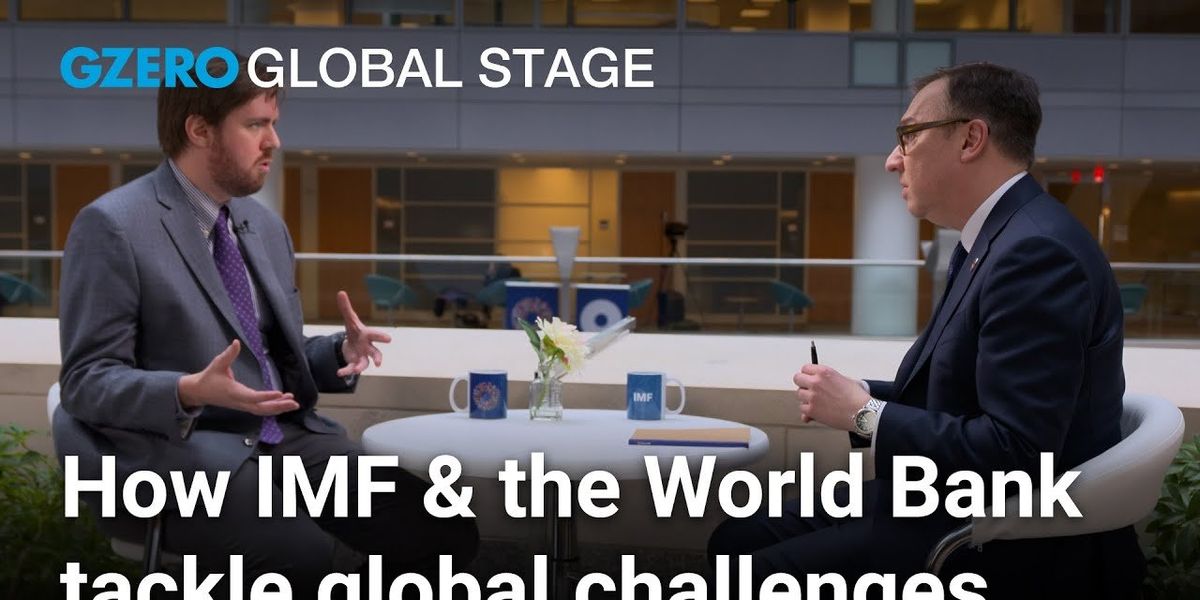Trending Now
We have updated our Privacy Policy and Terms of Use for Eurasia Group and its affiliates, including GZERO Media, to clarify the types of data we collect, how we collect it, how we use data and with whom we share data. By using our website you consent to our Terms and Conditions and Privacy Policy, including the transfer of your personal data to the United States from your country of residence, and our use of cookies described in our Cookie Policy.
{{ subpage.title }}
How to tackle global challenges: The IMF & World Bank blueprint
The International Monetary Fund and World Bank’s Spring Meetings in Washington have told a tale of two economies: In the developed world, inflation is falling, and recession looks unlikely. But many of the world’s poorest countries are struggling under tremendous debt burdens inflated by rising interest rates that threaten to undo decades of development progress. That means these key lenders of last resort have their work cut out for them.
The good news? There’s a proven model, as GZERO Senior Writer Matthew Kendrick discussed with Tony Maciulis at a Global Stage event while reporting on the meetings. Somalia, once the byword for a failed state, managed to implement massive reforms to its financial system to meet the guidelines of the IMF’s Highly Indebted Poor Countries Initiative.
“Because they met those guidelines — while still in a very fragile environment where they were fighting Islamic extremists in the country, dealing with semi-autonomous zones in the north — they managed to discharge 90% of their debt,” said Kendrick. “It's proof that even in very fragile countries, if, as the Somali finance minister said yesterday, you build these projects into nationally unifying efforts to build a better future, they can have tremendous success.”
Kendrick also cited comments from experts calling for the IMF and World Bank to change how they view humanitarian work more generally and not back away from countries amid war. “Conflicts are becoming a day-to-day part of our lives all over the world,” he says. “That means that the IMF and World Bank, in order to make progress on development, have to figure out ways to work with the institutions in these countries as they are also in conflict.”
For more of our 2024 IMF/World Bank Spring Meetings coverage, visit Glogal Stage.
- IMF says economic picture is rosy, but how does it look from the bottom? ›
- Debt limits of rich countries hurt poor countries' growth, says World Bank's Malpass ›
- What We're Watching: Nigerians vote, Biden's World Bank pick ›
- World Bank economist: The poorest are getting poorer globally ›
- With electric bills soaring, should the EU cap natural gas prices? ›
- Why Africa's power partnership with the World Bank should attract investors - GZERO Media ›
Ian Explains: Why is global debt so high?
As of 2023, global debt as ballooned to an eye-watering $300 trillion. That’s an average of $37,500 for every person on the planet.
Why is global debt so high? Decades of low interest rates and cheap good made money easy to borrow. Then, along came a pandemic which stalled growth and a war in Ukraine that drove food and energy prices through the roof.
While these crises impacted just about every nation on Earth, they didn’t react in the same way. The US and the European Union pumped trillions of pandemic stimulus money into their economies to keep them afloat, but poorer nations kept borrowing money they couldn’t afford to pay back. Now, an estimated 60% of those countries are facing debt distress and rising inflation means paying down those bills is more expensive.
Can the world do anything about the impending debt crisis before it’s too late?
On GZERO World, Ian explains what the debt problem means for the global financial system and whether it needs to be transformed to confront the economic realities of the developing world.
Podcast: Fix the global debt crisis before it's too late, warns World Bank's David Malpass
Listen: In his final interview as World Bank president, David Malpass sits down with Ian Bremmer on the GZERO World podcast to discuss all things debt. No, not your credit card or mortgage payments, but the sovereign debt that governments use to pay their bills.
Global debt has ballooned to an eye-watering $300 trillion due to decades of low interest that made borrowing money extremely cheap, followed by runaway inflation driven by the pandemic and war in Ukraine. This dynamic has forced a lot of nations––particularly the poorest––to borrow more money than it can pay back.
In a wide-ranging interview, Malpass explains how the global debt crisis got so bad and whether there's any hope of averting economic disaster before it's too late. He also reflects on his tenure as World Bank president, advice for his successor, China's emergence in the 21st century as the world's creditor, and why the US debt limit law needs to be rewritten.
Subscribe to the GZERO World Podcast on Apple Podcasts, Spotify, Stitcher, or your preferred podcast platform, to receive new episodes as soon as they're published.- Odds of a global recession? 50/50, says David Malpass ›
- Explaining the long history of US debt (& which other countries are saddled with debt) ›
- US debt default would be "destabilizing," says World Bank's David Malpass ›
- World faces "lost decade" of economic growth, says World Bank economist ›
- Inequality isn't inevitable - if global communities cooperate ›
- Graphic Truth: Global inequality ›
- Debt limits of rich countries hurt poor countries' growth, says World Bank's Malpass - GZERO Media ›
- Ian Explains: Why is global debt so high? - GZERO Media ›
- World Bank economist: The poorest are getting poorer globally - GZERO Media ›

